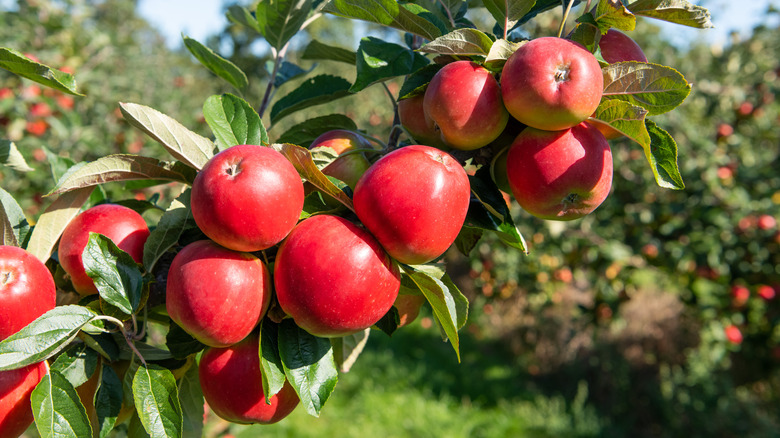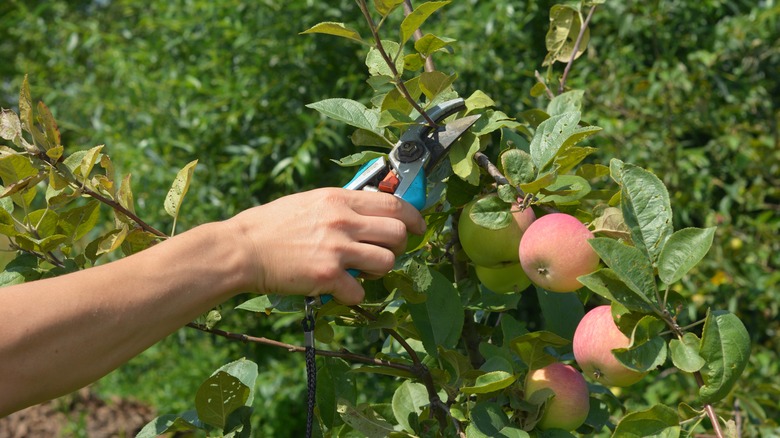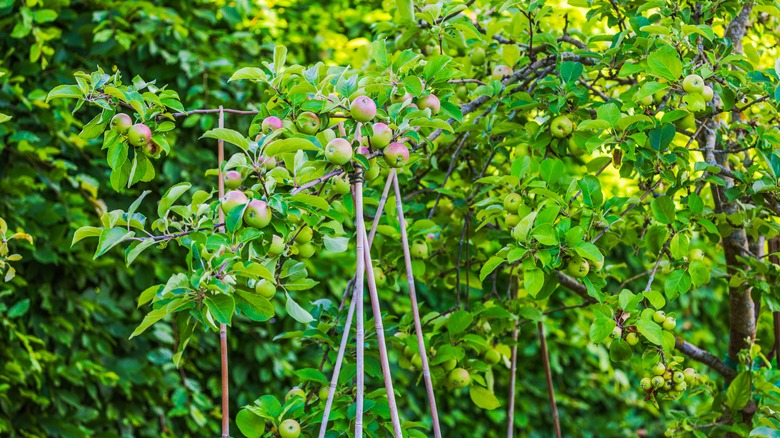How To Protect Your Apple Tree If Fruit Is Weighing Down The Branches
An abundant harvest of apples in autumn is a delight for the home orchardist. But some years, a bumper crop of apples can cause unanticipated stress to apple trees when there is more or heavier fruit than normal. This additional stress can cause branches to bend or even break. There are a few ways to protect your apple tree to help avoid breakage, but prevention is by far the best solution to this problem, and the best mode of prevention is regular pruning.
Apple trees need pruning to keep their branching structure healthy and manageable. But sometimes, even a regularly pruned tree might produce an overabundance of apples, or heavier than normal fruit. When this occurs, the heaviness of the fruit can make branches and limbs vulnerable to breakage. Small branches breaking off isn't too much of a problem, but when larger branches or limbs are damaged, it can harm the overall health of the tree, so it's best to avoid this situation.
Broken branches and limbs on apple trees can sometimes be repaired. A broken branch that is still partly attached can be reattached with grafting tape, and eventually the tree will mend itself. But this takes time, and may take several tries before it is successful. A broken limb with a ragged edge should be pruned or cut so that the edge is clean, ideally when the tree has begun to go dormant in late fall. Taking care to prune apple trees regularly to prevent damage is still the best solution to the problem of heavy fruit breaking branches.
Thinning vs pruning to avoid breakage
If your apple tree's limbs are bending or sagging from the weight of too much or too heavy fruit, you should intervene quickly to prevent branches from breaking. The first thing to do is thin some of the fruit to lessen the strain on the tree. Take some pruning shears and snip off a few apples, cutting a bit of the branch just above the stem. It's frustrating to have to remove the apples before they've ripened, but the health of the tree is at stake. Wildlife will often eat early fallen apples, so you can leave them in the woods for deer and other animals.
You can also thin apples from the branches when they are still small, before the weight has become an issue. This can be done when it's apparent that your apple tree will be producing a larger than usual number of apples, or if you didn't have a chance to prune in spring. The good thing about this method is that thinning small apples will allow the tree to direct more of its energy to the remaining apples, ensuring a good harvest.
Major pruning of your apple tree should be done in late winter well before blossom time, while the tree is still somewhat dormant, between mid to late March. At this time it's best to only prune small to medium sized branches. Prune to let some light show through the tree; this is a good sign you've pruned properly. Larger limbs (more than two inches in diameter) should be pruned in late autumn during the tree's dormant season, after the last apples have fallen or been harvested. Try to get in the habit of adding yearly pruning to your fruit tree care routine.
Protecting a tree that has branches heavy with apples
To keep the fruit on your tree but also protect the branches from possible breakage, you can try using support stakes (also called props) to hold the tree in place. It may still be necessary to remove some apples before they ripen so you can put the stakes in place. For larger limbs you may want to make stakes (using large branches or, if you have woods, cut from young trees) with a "Y" shape at the top to support the weight. These can be wedged in place to support the apple tree boughs.
A slightly easier method is to make simple trellis supports. Use multiple stakes and tie the fruiting branches to them to help disperse the weight of the fruit. Use bamboo garden stakes at least an inch in diameter, or solid wooden dowels, or sturdy branches. Form a tripod shape into a sort of DIY trellis support (like you would for pole beans in the garden); this will help keep apples in place. Tie with pieces of twine or clothesline. This can provide adequate support until harvest, then you can prune the tree afterwards.
While there are some elaborate orchard trellis system designs, you can also make simple ones. There are any number of ways to do this support creatively using found materials. The key thing to keep in mind is that you want to protect the tree's branches, avoiding the potential for breakage, and also be able to harvest the fruit as usual. Regular pruning is probably less work than propping up apple trees on stakes, but this is a good method to learn how to use in case there's a year when, despite your best efforts, your apple trees produce an overabundance of fruit that weigh down its branches.


